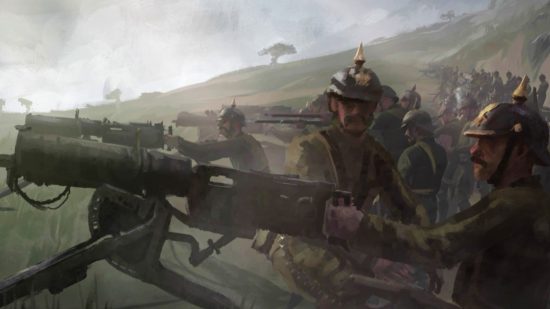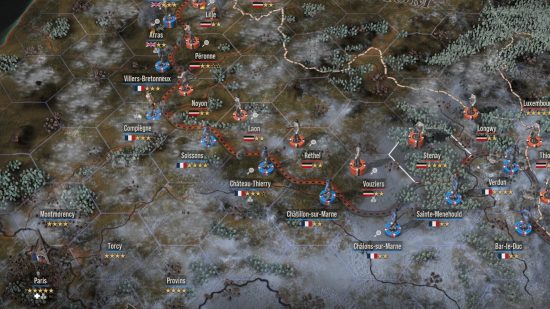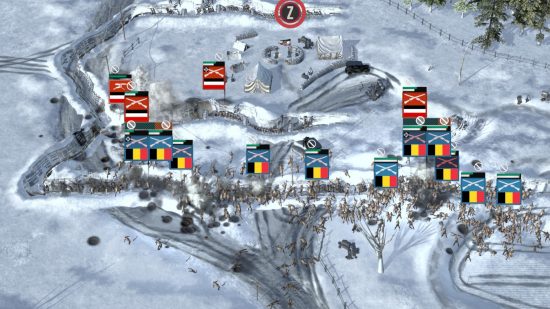Our Verdict
Grim-faced dedication to history has produced a rules-heavy RTS that's rarely fun or strategically rewarding - a highly accurate depiction of the First World War, in other words, and a success in that respect at least.
After hours spent poring over the front lines and filthy trenches of one of humanity’s most brutal and depressing conflicts, the first thing I find myself wondering as I collect my thoughts to write our Great War: Western Front review is, “how much fun am I supposed to be having?” The grim subject matter on its own makes this the kind of strategy game one plays with a furrowed brow, but there are technical and design problems that have conspired to make this an unpleasant and frustrating experience as well.
An issue that will likely make The Great War a difficult sell for most RTS players is its ungainliness. This is not the kind of game you can just pick up and play, and no wonder: the First World War is a unique conflict that represents the grisly ‘peak’ of what military historians call second-generation warfare. The heroic cavalry charges of Napoleon’s era gave way to the artillery barrage, the trench line, and the miles of barbed wire strung between France and Belgium from 1916 to 1918.

The Great War: Western Front is an attempt to represent all this, and that necessarily involves a stark departure from the RTS games the Westwood veterans at Petroglyph made their names on. Each battle involves setting up systems of trenches and placing field improvements like machine gun nests, artillery batteries, and observation balloons before sending companies of tiny soldiers in to stare across no man’s land watching for the next attack wave.
These battles grow more complex over the course of the campaign, as I unlock new technologies like poison gas, bomber planes, and devastating siege artillery. I can improve my trenches and research better helmets for my infantry, giving them – on paper, at least – a better shot at surviving the mad dash across the field before they leap headlong into the enemy’s trenches to engage in melee.
There’s also a wargame-style campaign on top of all this, in which I take command of either the Allies or Central Powers and attempt to push the front line forward wherever I can. There’s plenty to manage here as well, including espionage, supply logistics, and ultimately national will – the exhaustion of which is the campaign’s loss condition.
There’s a big part of me that admires the commitment to principle on display in The Great War: Western Front. Real-time battles most often result in frustrating stalemates that accomplish nothing beyond burning supplies and getting a lot of men killed. Even successful attacks aren’t enough on their own: each tile on the map has a star rating that’s similar to a fortification level in a more traditional wargame like Gary Grigsby’s War in the East 2. A tile with three stars, like Ypres, requires three ‘Great Victory’ battle results in order to capture. Key locations like Luxembourg, Calais, and Verdun have four or even five stars – and if I break off the attack on a location for a single turn, it’ll regain one of the stars I’ve taken out. There’s little room here for strategic expression: the only option is to keep throwing men into the meat grinder and to hope for the best.
This is an admirably accurate way to represent the Western Front, and, for better or for worse, it makes for an utterly gruelling play experience. Battlefield fortifications I make in any location persist, and are present when I inevitably fight there again – which I do, a lot. I’ve stared at the same battlefields countless times, as winter turns to spring and spring into summer, and the maps themselves devolve into blasted mud pits stripped of vegetation, structures, and any terrain features higher than an artillery crater.
The centrepiece of The Great War is the real-time tactical battles, and I’ve struggled to enjoy these as well – if indeed I’m meant to be enjoying them at all. Again, the subject matter comes into play here: sending three companies of soldiers to their almost certain deaths in the vain hopes of getting a foothold in an enemy trench is depressing, but it’s true to the nature of the conflict at least.
More frustrating, though, is when I can see that things aren’t working the way they’re supposed to. I’ll frequently see that men who aren’t under fire are marked as ‘suppressed,’ meaning they’ve got their heads down and cannot return fire on advancing infantry. It’s strange, too, since the only thing that seems capable of hitting them at all while they’re in trenches is artillery – no rifle fire will touch them, and tanks don’t even bother trying.
Then there’s the enemy AI, which is clever enough to use cheese tactics like sending a parade of companies around the extreme edge of a map to march through a gap in my trench networks – and okay, I suppose I should have sealed that up in the preliminary phase, but it was immersion-breaking enough for me to reload a save.
For players who are extremely interested in WWI, The Great War: Western Front has some compelling ideas, and I think it’s a valuable lesson in the nature of that war, on both the tactical and strategic levels. The trouble for me, however, is that none of that adds up to a game that’s a joy to play. Perhaps that’s as it should be.


